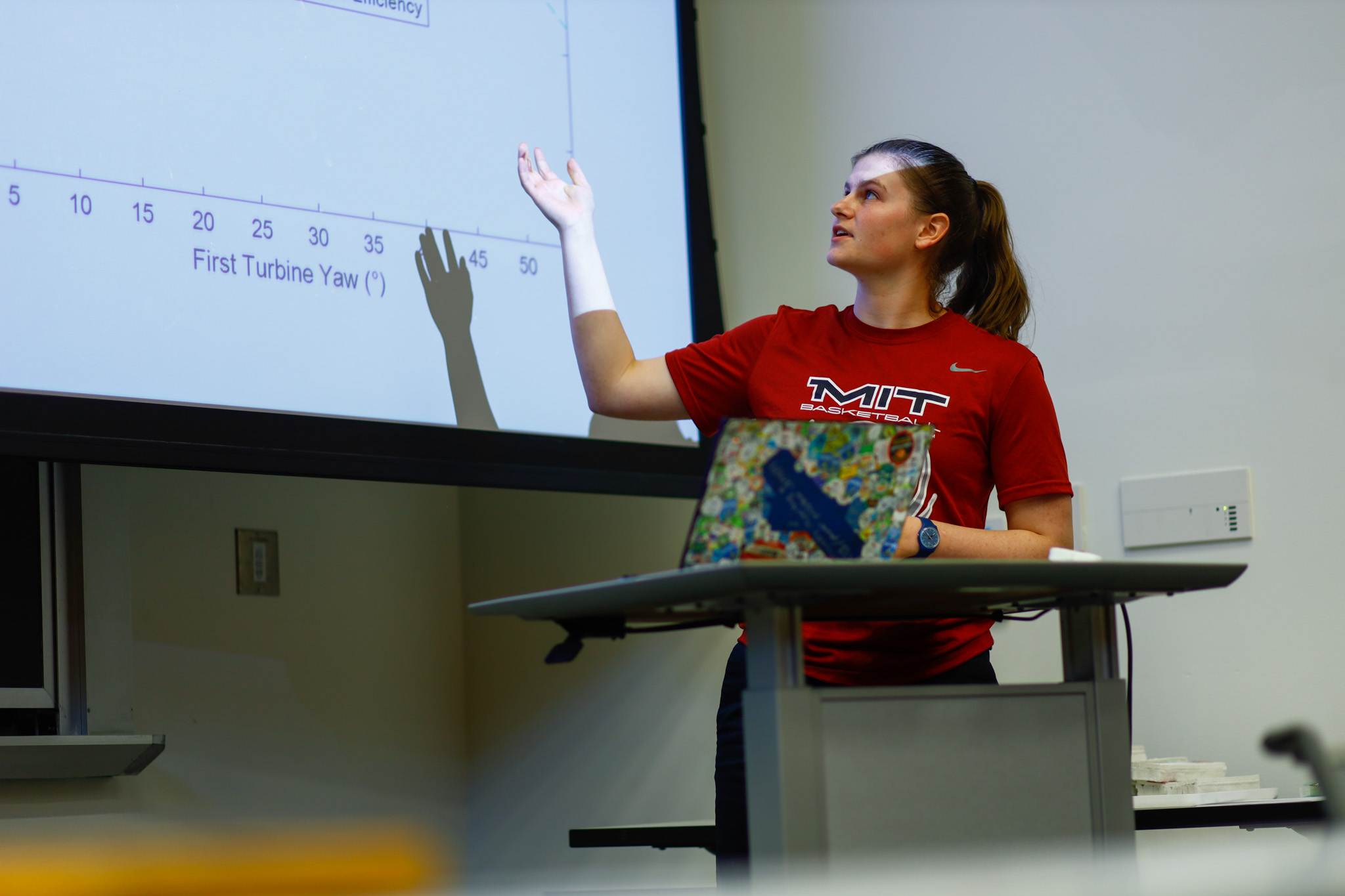Student Spotlight: Maximizing Wind Farm Power with Physics-based Models
January 25, 2024

Grace presenting her Scholars Program research project to her peers.
Through the MCSC Climate & Sustainability Scholars Program, MIT student Grace Harrington had the opportunity to research how to maximize wind farm power through physics-based computational models alongside the Howland Lab. These models help bridge the gap between academia and industry – with the goal of providing a better balance between analysis time and precision. Inspired by her Civil and Environmental Engineering major and Energy Studies minor, researching wind turbines caught Grace’s attention because this path allowed her to better understand the fascinating scale of operation behind widespread renewable energy infrastructure.
Grace's Research: A Physics-based Model of a Wind Turbine Array
When it comes to the technology behind the wind energy sector and designing wind farms, researchers are utilizing physics-based models to understand the aerodynamics of turbines.
In wind turbine configurations, the interaction of wakes on downwind turbines can result in a 10-20% loss in energy production across the entire farm. Thus, it is critical to understand the interaction of wakes on downstream turbines since the amount of power available to a singular turbine is proportional to the incoming velocity cubed. Models such as this one help analyze the airflow around the rotor of a turbine. This is necessary because it is time-intensive and expensive to numerically solve for the wind field within wind farms using computational fluid dynamics. Consequently, wind turbine research relies on physics-based models to capture as much detail as possible.
Throughout her time in the Scholars program, which allows students to work directly with faculty and principal investigators across MIT to develop their research projects focused on a large scope of sustainability topics, Grace’s research focused on changing wind turbine angles. She investigated how changing the angles of the turbines relative to the incoming wind (called yawing) could deflect turbine wakes away from downstream turbines, increasing power production across a farm. Her research helps provide confirmation that improving the efficiency of a wind turbine operation is possible through adjustment, and that this process of “yawing” allows for less infrastructure to be constructed in order to meet energy demands.
Balancing Precision with Time
Through her own research and contributions to the project, Grace’s goal has been to assist in calibrating an efficient model that requires less computational resources with more accurate results.
The most precise models are Large Eddy Simulations, but they require hundreds of computational hours to analyze the behavior of just one turbine. The Howland Lab has developed a more efficient model that aims to predict the behavior of a single turbine as well as the dynamics across a whole wind farm. This research is important, and particularly appealing to industry, because it allows for these less intensive models to be scaled more quickly and provide a larger grasp of the whole turbine array.
In order to capture the behavior of the interaction between the turbines and the wind, Grace applied the principles of fluid dynamics. Grace’s research concluded that scaling up from the wake of one turbine to a full array requires additional considerations to capture a reasonable level of the wake behavior.
Grace used stakeholder interviews to understand the pain points and constraints associated with implementing new technology, including yawing turbines. She chose to focus on connecting with people who are currently trying to implement technologies into the wind industry or those who are on the receiving end.

Grace observing a lecture during the classroom component of the Scholars Program.
“It was clear that there is a lot of excitement about introducing new technologies into the field due to the short timescale that the wind industry as a whole is working under to make impactful change on the grid.”
The stakeholder interviews also revealed two main limitations to getting new technology into the field. The first is that original equipment manufacturers can be protective of the distinguishable software used in their turbines. The second is that the process of introducing new technologies can be more impacted by the techno-economic factors surrounding the technology than the technical details themselves. Interviewing both academic and industry perspectives allowed Grace to conclude that keeping the needs of industry in mind during the development of the model will shape the types of questions to explore, such as focusing on overall energy production, but also the format and usability of the model.
Learning from Interdisciplinary Climate Experts
One aspect of the MCSC Scholars Program that stood out to Grace was having the opportunity to learn more about the perspectives and approaches to climate themes.
“Something that I expected going into the program was students working towards sustainability from a wide range of majors, but I was pleasantly surprised by the fact that most guest speakers were from a wide range of disciplines,” Grace said. Attending these lectures allowed her to hear from diverse thought leaders and experts with a commitment towards environmental impact.
“The most valuable takeaway was realizing how people in every discipline are able to positively contribute to meeting our climate goals."
Through guest lectures and hands-on experience, the MCSC Scholars Program provided an environment for Grace to explore different careers within the climate sphere. All of her conversations with researchers, PhD students, and industry stakeholders exposed her to the different ways she could continue to contribute to mitigating the impacts of the climate crisis.
“Originally I chose wind energy as it seemed like an obvious choice for my research project; however, throughout the program I was exposed to so many other areas that I had not even thought about,” said Grace. “Ultimately, it was reassuring to know that I will be able to incorporate my passion for sustainability into any future career.”
Grace is currently a teaching assistant for an energy systems class, and she is excited to spend her last year at MIT continuing to explore her place within the climate sphere.
